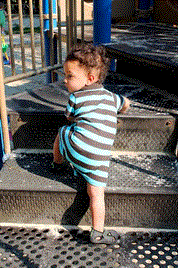Stairs are an important part of our everyday lives. Many families have stairs inside or leading into their homes. Other families may not have stairs in their home but will visit friends’ or relatives’ houses that have stairs. Common questions that parents often ask therapists are: “When should my child be able to crawl or walk up the stairs” and “How can I help my child safely come down the stairs?”
Children should be able to crawl up the stairs around 13 months, walk up and down the stairs with a railing or support around 15 months, and walk up and down the stairs without assistance around 24-26 months. Therapists will often use steps or stairs to work on strengthening a child’s leg or core muscles, practice coordination, body awareness, balance, and motor planning skills.
When families don’t have accessible stairs, there are many other ways that we can practice strengthening the same muscles and coordination patterns required for stair climbing.
Common household items with which to practice stair climbing skills:
- Step stools (single or double step)
- Cardboard boxes – reinforced with duct tape
- Toy bins
- Tupperware bins
- Thick books
- Firm cushions from the couch
- Parent’s leg
How can you set up common household items to help your child improve their strength and coordination to climb up and down stairs and what skills will this work on?
- You can get varying heights of step stools to practice stepping or crawling up and down from a step
- Stepping up/down from step stools also works on body awareness so that kids have to pay attention to foot placement when they step on/off
- Standing on a step stool also works on balance since they have to stand with their feet closer together and can’t just step in any direction
- You can make this easier by putting the step stools against the couch so your child can lean against the couch as they walk up the steps
- You can make it harder by putting the step stools in the middle of the room and increasing the space between the step stools
- You can also wrap phone books (or other books) or boxes in duct tape to have a smaller distance to step up and down.
Couch Cushions:
- You can use these the same way you use step stools.
- These are easier because they are wider than step stools giving your child more space and allowing them to focus on strengthening their legs
- At the same time couch cushions can be a little more difficult because they are unstable and challenge their balance skills
In the community you can also find stairs or steps at:
- Restaurant play areas
- Mall play areas
- Slide steps
- Curbs
Outside on playground equipment:
- Using playground equipment is a great way to practice actual stairs that are a little smaller and just the right size for your child. This can be helpful for families that have steep stairs in their home.
Getting outside:
- Practicing on curbs also provides a real functional activity that kids will encounter in their daily lives
- You can walk around your neighborhood and search for different height curbs and curbs that are all cement or have grass to make the activity more challenging.
By: Anna Romanosky, PT



